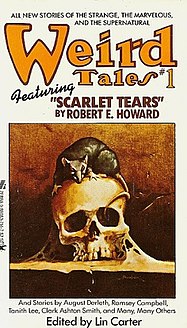 W
WThe Ballantine Adult Fantasy series was an imprint of American publisher Ballantine Books. Launched in 1969, the series reissued a number of works of fantasy literature which were out of print or dispersed in back issues of pulp magazines, in cheap paperback form—including works by authors such as James Branch Cabell, Lord Dunsany, Ernest Bramah, Hope Mirrlees, and William Morris. The series lasted until 1974.
 W
WFlashing Swords! is a series of fantasy anthologies published by Dell Books from 1973 to 1981 under the editorship of Lin Carter. It showcased the heroic fantasy work of the members of the Swordsmen and Sorcerers' Guild of America (SAGA), a somewhat informal literary group active from the 1960s to the 1980s, of which Carter was the guiding force. Most of the important sword and sorcery writers at the time of the group’s founding were members; later, membership was extended to other fantasy authors.
 W
WThe Harry Potter series of fantasy novels by J. K. Rowling is one of the most translated series of all time, with the first book, Harry Potter and the Philosopher's Stone, having been translated into over 76 languages. This includes languages diverse as Azerbaijani, Malayalam and Welsh as well as the dead languages Latin and Ancient Greek. This makes it the longest published work in Ancient Greek since the novels of Heliodorus of Emesa in the 3rd century AD. Additionally, regional adaptations of the books have been made to accommodate regional dialects such as the American English edition or the Valencian adaptation of Catalan.
 W
WThe Newcastle Forgotten Fantasy Library was a series of trade paperback books published in the United States by the Newcastle Publishing Company between 1973 and 1980. Presumably under the inspiration of the earlier example set by the Ballantine Adult Fantasy series, the series reissued a number of works of fantasy literature that had largely been forgotten, being out of print or otherwise not easily available in the United States, in durable, illustrated trade paperback form with new introductions. For a number of works the Library’s editions constituted the first U.S. or first paperback edition. Together with the earlier series from Ballantine Books, it contributed to the renaissance of interest in the fantasy genre of the 1970s.
 W
WWeird Tales was a series of paperback anthologies, a revival of the classic fantasy and horror magazine of the same title, published by Zebra Books from 1980 to 1983 under the editorship of Lin Carter. It was issued more or less annually, though the first two volumes were issued simultaneously and there was a year’s gap between the third and fourth. It was preceded and succeeded by versions of the title in standard magazine form.
 W
WWerewolf fiction denotes the portrayal of werewolves and other shapeshifting man/woman-beasts, in the media of literature, drama, film, games, and music. Werewolf literature includes folklore, legend, saga, fairy tales, Gothic and Horror fiction, fantasy fiction and poetry. Such stories may be supernatural, symbolic or allegorical. A classic American cinematic example of the theme is The Wolf Man (1941) and in later films joins with Frankenstein's monster and Count Dracula, as one of the three famous icons of the modern day horror. However, werewolf fiction is an exceptionally diverse genre with ancient folkloric roots and manifold modern re-interpretations.
 W
WThis is a list of fiction and media of all kinds of media featuring werewolves, lycanthropy and shape-shifting.
 W
WThe Year’s Best Fantasy Stories was a series of annual anthologies published by DAW Books from 1975 to 1988 under the successive editorships of Lin Carter from 1975 to 1980 and Arthur W. Saha from 1981 to 1988. The series was a companion to DAW’s The Annual World’s Best SF, issued from 1972 to 1990 under the editorship of Saha with publisher Donald A. Wollheim, and The Year's Best Horror Stories, issued from 1971 to 1994, which performed a similar office for the science fiction and horror fiction genres.